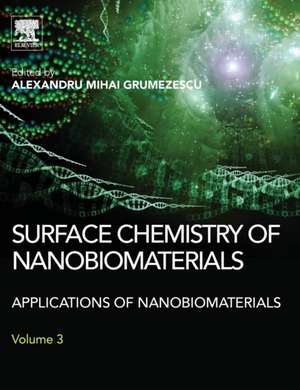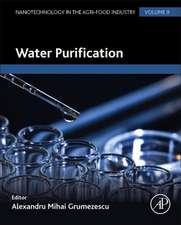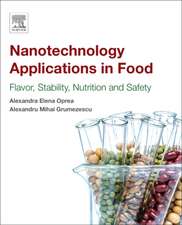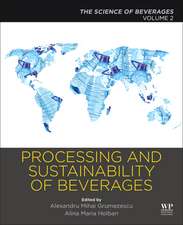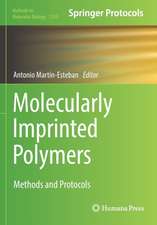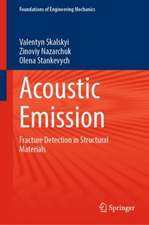Surface Chemistry of Nanobiomaterials: Applications of Nanobiomaterials
Editat de Alexandru Grumezescuen Limba Engleză Hardback – 24 feb 2016
Leading researchers from around the world present various types of nanobiomaterials, such as quantum dots (QDs), carbon nanotubes, silver nanoparticles, copper oxide, zinc oxide, magnesium oxide, magnetite, hydroxyapatite and graphene, and discuss their related functionalization strategies.
This book will be of interest to postdoctoral researchers, professors and students engaged in the fields of materials science, biotechnology and applied chemistry. It will also be highly valuable to those working in industry, including pharmaceutics and biotechnology companies, medical researchers, biomedical engineers and advanced clinicians.
- An up-to-date and highly structured reference source for researchers, practitioners and students working in biomedical, biotechnological and engineering fields
- A valuable guide to recent scientific developments, covering major and emerging applications of nanomaterials in the biomedical field
- Proposes novel opportunities and ideas for developing or improving technologies in nanomedicine and nanobiology
Preț: 835.51 lei
Preț vechi: 1111.01 lei
-25% Nou
Puncte Express: 1253
Preț estimativ în valută:
159.90€ • 166.32$ • 132.00£
159.90€ • 166.32$ • 132.00£
Carte tipărită la comandă
Livrare economică 08-22 aprilie
Preluare comenzi: 021 569.72.76
Specificații
ISBN-13: 9780323428613
ISBN-10: 0323428614
Pagini: 528
Dimensiuni: 191 x 235 x 30 mm
Greutate: 1.3 kg
Editura: ELSEVIER SCIENCE
ISBN-10: 0323428614
Pagini: 528
Dimensiuni: 191 x 235 x 30 mm
Greutate: 1.3 kg
Editura: ELSEVIER SCIENCE
Public țintă
Academic: Materials science, biotechnology and applied chemistry professors, PhD, MsC, postdocs, upper level undergraduate students.Industry: Pharmaceutics and biotechnology companies, medical researchers, biomedical engineers, advanced clinicians.
Cuprins
Chapter 1. Surface functionalized hybrid nanomaterials: Implications in biosensing and therapeutics
Chapter 2. Microbial toxicity of different functional groups-treated carbon nanotubes
Chapter 3. Making the hospital a safer place by the sonochemical coating of textiles by antibacterial nanoparticles
Chapter 4. Nano-microporous structured surfaces prepared by the breath figures approach and their biorelated applications
Chapter 5. Surface chemistry of nanobiomaterials with antimicrobial activity
Chapter 6. Nanotechnology from particle size reduction to enhancing aqueous solubility
Chapter 7. Formation of biomimetic hydroxyapatite coatings on the surface of titanium and Ti-containing alloys: Ti–6Al–4V and Ti–Zr–Nb
Chapter 8. Interaction between nanoparticles and cell membrane
Chapter 9. Antimicrobial studies of metal and metal oxide nanoparticles
Chapter 10. Inorganic nanoarchitectonics designed for drug delivery and anti-infective surfaces
Chapter 11. The chemistry of magnetosomes
Chapter 12. Nanomaterials and natural products for UV-photoprotection
Chapter 13. Progress in graphene-based optical and electrochemical aptasensors
Chapter 14. Improved oral bioavailability of bioactives through lipid-based nanoarchitectures
Chapter 15. Scientometric overview regarding the surface chemistry of nanobiomaterials
Chapter 2. Microbial toxicity of different functional groups-treated carbon nanotubes
Chapter 3. Making the hospital a safer place by the sonochemical coating of textiles by antibacterial nanoparticles
Chapter 4. Nano-microporous structured surfaces prepared by the breath figures approach and their biorelated applications
Chapter 5. Surface chemistry of nanobiomaterials with antimicrobial activity
Chapter 6. Nanotechnology from particle size reduction to enhancing aqueous solubility
Chapter 7. Formation of biomimetic hydroxyapatite coatings on the surface of titanium and Ti-containing alloys: Ti–6Al–4V and Ti–Zr–Nb
Chapter 8. Interaction between nanoparticles and cell membrane
Chapter 9. Antimicrobial studies of metal and metal oxide nanoparticles
Chapter 10. Inorganic nanoarchitectonics designed for drug delivery and anti-infective surfaces
Chapter 11. The chemistry of magnetosomes
Chapter 12. Nanomaterials and natural products for UV-photoprotection
Chapter 13. Progress in graphene-based optical and electrochemical aptasensors
Chapter 14. Improved oral bioavailability of bioactives through lipid-based nanoarchitectures
Chapter 15. Scientometric overview regarding the surface chemistry of nanobiomaterials
